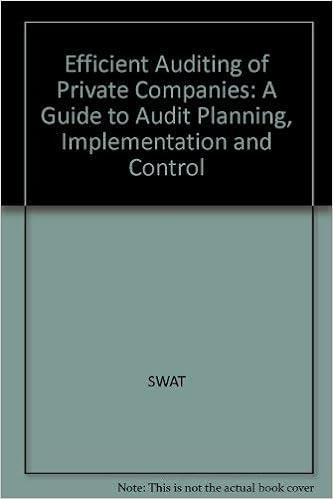Question
Hampton Company sells office equipment to small and medium-sized business. They had a very good year in 2012. They increased net sales from $ 4,000,000
Hampton Company sells office equipment to small and medium-sized business. They had a very good year in 2012. They increased net sales from $ 4,000,000 in 2011 to $ 5,200,000 in 2012. In 2011, Hampton made $ 1,700,000 of their sales on credit, and had an A/R turnover of 3.6. In 2012, they made $ 2,900,000 of their sales on credit. In 2010, they implemented a new strategy that included selling to customers with weaker credit and extending payment terms on their receivables. Because of this increased risk, they required a larger number of new customers to sign written payment agreements, but they have not changed their estimates of uncollectible accounts since 2006. Below is an accounts receivable aging schedule for the end of 2011 and the end of 2012:
2011 Accounts Receivable Aging Schedule
Age Amount % Estimated Uncollectible
Under 30 days $ 975,000 3%
30-60 days $ 443,000 9%
60-90 days $ 98,000 20%
Over 90 days $ 45,000 50%
2012 Accounts Receivable Aging Schedule
Age Amount % Estimated Uncollectible
Under 30 days $ 1,700,000 3%
30-60 days $ 680,000 9%
60-90 days $ 127,000 20%
Over 90 days $ 51,000 50%
Hampton uses the percentage of receivables method to determine net realizable value of their receivables. During the course of 2012 they wrote-off $14,000 in receivables. Please answer the following questions:
A.Please record the journal entry to adjust Allowance for Doubtful Accounts at 12/31/12.
B.Please calculate the Accounts Receivable turnover as of 12/31/12.
C.If you were auditing Hampton Co, would you agree that their ending balance in the Allowance for Doubtful Accounts is acceptable? In paragraph form, please state your conclusion and give at least two reasons for your answer. If it is not appropriate, what should Hampton change?
Additionally, during the course of 2012, Hampton Company made sales to two new customers, who were starting new businesses. Hampton Company required them to sign the following notes:
1.On June 1, 2012, Zimmerman, Inc. purchased $85,000 of equipment. Zimmerman signed a note that required $ 10,000 down with the remainder due in 6 quarterly installments (due on Sept 1, Dec 1, Mar 1, June 1). The interest rate on the note is 13%.
2.On Oct 1, 2012, Mueller, Inc. purchased $57,000 of equipment. On that day, Mueller signed a 12-month, $65,000 zero-interest-bearing note. The implicit rate on the note is 14%.
With regards to these notes, please make the following journal entries for Hampton:
A.The journal entries to record the initial sale of equipment, receipt of cash, and note receivable for both notes.
B.Any payments made by Zimmerman or Mueller during the course of 2012.
C.Interest revenue accrued as of 12/31/12.
Step by Step Solution
There are 3 Steps involved in it
Step: 1

Get Instant Access to Expert-Tailored Solutions
See step-by-step solutions with expert insights and AI powered tools for academic success
Step: 2

Step: 3

Ace Your Homework with AI
Get the answers you need in no time with our AI-driven, step-by-step assistance
Get Started


